
Dasyuris is a genus of moths in the family Geometridae first described by Achille Guenée in 1868.

Sabatinca caustica is a species of moth belonging to the family Micropterigidae. It was described by Edward Meyrick in 1912. It is endemic to New Zealand and is found in both Southland and at Stewart Island / Rakiura. The adults of this species are variable in appearance with some specimens being mainly white on their forewings while others have forewings that are a more mottled purple-brown colour. Adults are on the wing from the start of October until the middle of December. Larvae feed on the surface of leafy liverworts.

Sabatinca calliarcha is a species of moth belonging to the family Micropterigidae. It was described by Edward Meyrick in 1912. It is endemic to New Zealand. It is found in two separate areas of New Zealand - the first in the norther parts of the North Island including Great Barrier Island and the second population can be found from the top of the South Island down to Southland. The adults of the species are on the wing from the end of September until the middle of January. The species prefers to inhabit damp forests and larvae likely feed on leafy liverwort species. Adult moths likely feed on the spores of ferns or the pollen of sedge grasses.
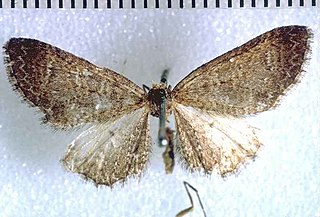
Pasiphila acompsa is a moth in the family Geometridae. It was described by Louis Beethoven Prout in 1927. It is endemic to New Zealand and has been observed in mountainous locations in both the North and South Islands. Larvae of this species have been reared on plants within the Veronica genus. Adults are on the wing from December to February.
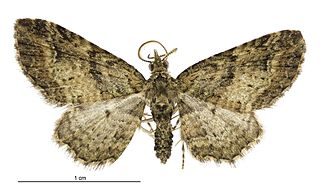
Pasiphila charybdis is a species of moth in the family Geometridae. It is endemic to New Zealand.

Anisoplaca acrodactyla is a species of moth of the family Gelechiidae. It was described by Edward Meyrick in 1907 and is endemic to New Zealand. This species has been observed in South Island as well as in the North Island. Larvae feed on species in the genera Hoheria and Plagianthus including the species Plagianthus regius'.

Meterana pansicolor is a species of moth in the family Noctuidae. It is endemic to New Zealand. This species is classified as "At Risk, Naturally Uncommon" by the Department of Conservation.
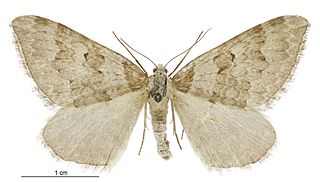
Xanthorhoe frigida is a species of moth in the family Geometridae. It is endemic to New Zealand. It is classified as nationally vulnerable by the Department of Conservation.

Dasyuris partheniata is a species of moth in the family Geometridae. It is endemic to New Zealand. It is classified as "At Risk, Declining" by the Department of Conservation.

Hydriomena clarkei is a species of moth in the family Geometridae. This species is endemic to New Zealand. It is classified as "At Risk, Declining'" by the Department of Conservation.

Asaphodes cinnabari is a species of moth in the family Geometridae. This species is endemic to New Zealand and can be found in Otago and Southland where it lives in alpine swampy habitat. Adults of this species are on the wing in November.

Ichneutica cana is a moth of the family Noctuidae. It is endemic to New Zealand.
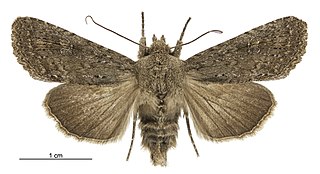
Physetica homoscia is a species of moth of the family Noctuidae. It is endemic to New Zealand and is found throughout New Zealand including in the Auckland Islands. This species inhabits places where its host plants are common and this includes costal dune habitat. It lives at a wide range of altitudes from sea-level up to at least 1750 m. The larvae of P. homoscia feed on Ozothamnus leptophyllus and Ozothamnus vauvilliersii. They are very active and drop to the ground when disturbed. Larvae are parasitised by a species of fly. This species pupates in the soil and the pupa life stage lasts for approximately 6 weeks. The adult moths are on the wing from September to June and are attracted to light. The adults of P. homoscia might possibly be confused with Ichneutica moderata however this latter species lacks the small white dots on the forewing veins of P. homoscia. Adults might also be confused with P. temperata but P. homoscia is significantly larger in size.
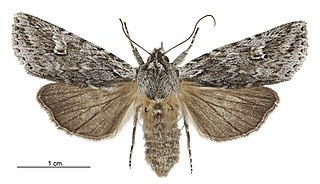
Physetica sequens is a species of moth of the family Noctuidae. It is endemic to New Zealand and can be found throughout the North and South Islands. It appears to be more common in the North Island than the South Island, and lives in open native shrublands, peatlands, Northland gumland, inland volcanic dunes, and Dracophyllum-dominated areas at altitudes that range from sea level to the alpine zone, up to at least 1600 m. Larvae of this species have been successfully reared on Leucopogon fasciculatus and Leptecophylla juniperina. The adults of this species are variable in appearance and are on the wing from September to March. P. sequens is similar in appearance to P. phricias but can be distinguished as P. phricias has a narrow black line along the dorsum of its forewing that P. sequens does not. P. sequens is also similar in appearance to P. cucullina however the forewing dorsum area of P. sequens does not have the narrow black line that is frequently present on P. cucullina forewings.

Proteodes smithi is a species of moth in the family Depressariidae. It is endemic to New Zealand and known from Homer in Fiordland.

Tingena brachyacma is a species of moth in the family Oecophoridae. It is endemic to New Zealand and has been found in the south of the South Island. This species inhabits open swamps, native forest and scrubland and has been collected amongst Leptospermum. The adults of the species are on the wing in November and December.

Asaphodes prymnaea is a moth in the family Geometridae. It is endemic to New Zealand and can be found on the Mount Arthur tableland. It is common in limestone valleys. The female of the species is paler and has less distinctive markings than the male. Adults are on the wing in January and February.

Meterana asterope is a species of moth in the family Noctuidae. This species is endemic to New Zealand and is found in the North and South Islands. It inhabits both native forest and open habitat and adults emerge during the New Zealand summer. Adults are on the wing in December and January. This species is attracted to light and has also been collected via sugar traps.

Orthenches chlorocoma is a moth of the family Plutellidae first described by Edward Meyrick in 1885. It is endemic to New Zealand and has been observed in the North and South Islands.

Orthenches dictyarcha is a moth of the family Plutellidae first described by Edward Meyrick in 1927. It is endemic to New Zealand and has been observed at Arthur's Pass and at Hollyford Valley in Fiordland. It is one of the larger species in its genus and is similar in appearance to O. homerica. Its preferred habitat is beech forest and adults are on the wing in January.





















